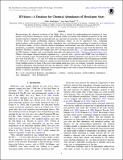JINAbase—A Database for Chemical Abundances of Metal-poor Stars
Author(s)
Abohalima, Abdu; Frebel, Anna; Frebel, Anna L.
DownloadAbohalima_2018_ApJS_238_36.pdf (1.842Mb)
PUBLISHER_POLICY
Publisher Policy
Article is made available in accordance with the publisher's policy and may be subject to US copyright law. Please refer to the publisher's site for terms of use.
Terms of use
Metadata
Show full item recordAbstract
Reconstructing the chemical evolution of the Milky Way is crucial for understanding the formation of stars, planets, and galaxies throughout cosmic time. Different studies associated with element production in the early universe and how elements are incorporated into gas and stars are necessary to piece together how the elements evolved. These include establishing chemical abundance trends, as set by metal-poor stars, comparing nucleosynthesis yield predictions with stellar abundance data, and theoretical modeling of chemical evolution. To aid these studies, we have collected chemical abundance measurements and other information, such as stellar parameters, coordinates, magnitudes, and radial velocities, for extremely metal-poor stars from the literature. The database, JINAbase, contains 1659 unique stars, 60% of which have [Fe/H] ≤ −2.5. This information is stored in an SQL database, together with a user-friendly queryable web application (http://jinabase.pythonanywhere.com).
Objects with unique chemical element signatures (e.g., r-process stars, s-process and CEMP stars) are labeled or can be classified as such. We find that the various neutron-capture element signatures occur in up to 19% of metalpoor stars with [Fe/H] ≤ −2.0, and 32% when also considering carbon enhancement. The web application enables fast selection of customized comparison samples from the literature for the aforementioned studies and many more. Using multiple entries for three of the most well-studied metal-poor stars, we evaluate systematic uncertainties of chemical abundance measurements between the different studies. We provide a brief guide to the selection of chemical elements for model comparisons for non-spectroscopists who wish to learn about metal-poor stars and the
details of chemical abundance measurements. Key words: astronomical databases: miscellaneous – catalogs – nuclear reactions, nucleosynthesis, abundances – stars: abundances – stars: Population II
Date issued
2018-10Department
Massachusetts Institute of Technology. Department of Physics; MIT Kavli Institute for Astrophysics and Space ResearchJournal
The Astrophysical Journal Supplement Series
Publisher
American Astronomical Society
Citation
Abohalima, Abdu, and Anna Frebel. “JINAbase—A Database for Chemical Abundances of Metal-Poor Stars.” The Astrophysical Journal Supplement Series 238, no. 2 (October 23, 2018): 36.
Version: Final published version
ISSN
1538-4365